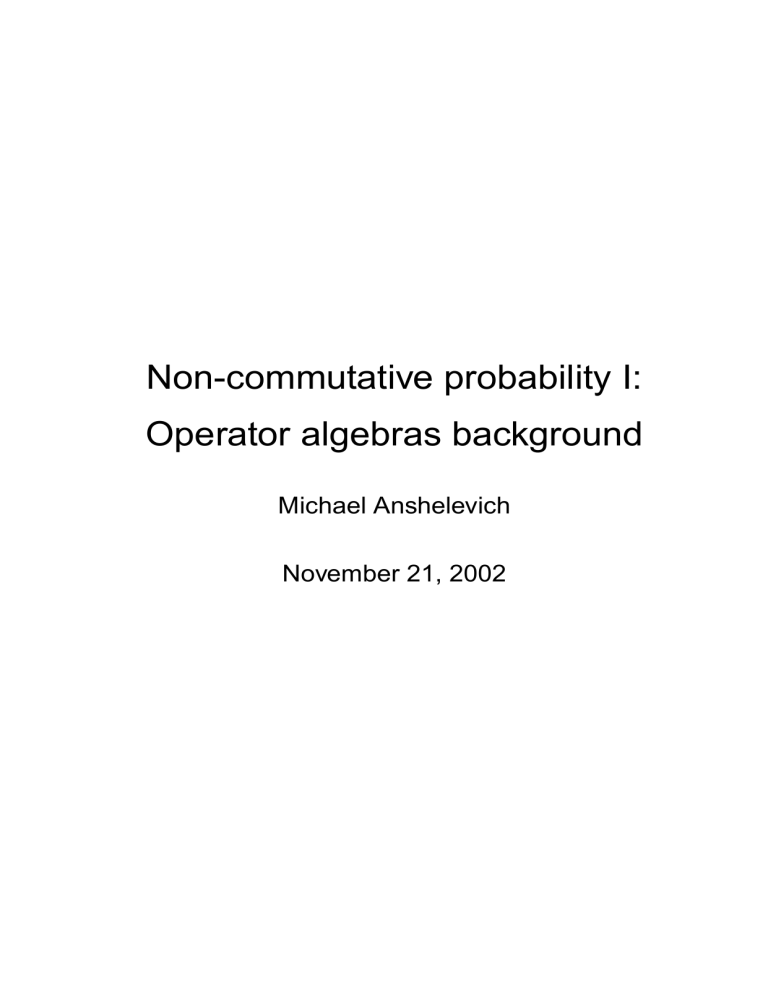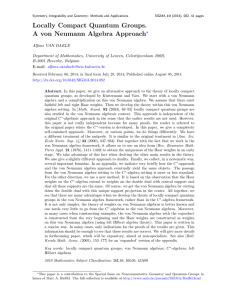Non-commutative probability I: Operator algebras background Michael Anshelevich November 21, 2002
advertisement

Non-commutative probability I:
Operator algebras background
Michael Anshelevich
November 21, 2002
Let (A, ϕ) be a non-commutative probability space.
A =∗-algebra with identity,
(αa + βb)∗ = ᾱa∗ + β̄b∗;
(ab)∗ = b∗a∗.
ϕ = linear functional A → C, a state, i.e. positive
ϕ a∗a ≥ 0,
unital
ϕ [1] = 1.
A is a C∗-algebra, has a norm k·k such that
kabk ≤ kak kbk ,
ka∗k = kak ,
and
ka∗ak = kak2 .
ϕ = norm-continuous.
1
Example . Let Ω be a compact set, then A = C(Ω, C)
is a C∗-algebra with complex conjugation f ∗ = f¯ and
supremum norm kf k = kf k∞. Note that
f f¯
∞
= kf k2
∞.
ϕ = expectation with respect to a probability measure P
on Ω,
ϕ [f ] =
Z
Ω
f (ω)dP (ω).
Theorem . Any commutative C∗-algebra is of this form.
Example . H = complex Hilbert space, A = norm-closed
∗-subalgebra of B(H), ϕ = vector state
ϕξ (a) = haξ, ξi .
Note
ka∗ak = sup ha∗aξ, ξi = sup haξ, aξi = kak2 .
ξ∈H,
kξk=1
ξ∈H,
kξk=1
Theorem . Any C∗-algebra is of this form.
2
Assume the state ϕ to be faithful: ϕ [a∗a] = 0 only if
a = 0 (“full support”).
G ELFAND -N AIMARK -S EGAL (GNS)
CONSTRUCTION .
Imitate representing C(Ω) on L2(Ω, P ).
Put on A the inner product ha, bi = ϕ [b∗a]. Faithful state
⇒ get a norm. Denote by L2(A, ϕ) the completion of A
with respect to this norm, by ã the element of L2(A, ϕ)
corresponding to a. Represent A on L2(A, ϕ) by
Lab̃ = (ab)˜.
Extend to all of L2(A, ϕ) with kLak = kak.
Let ξ = 1̃. hLaξ, ξi = ha, 1i = ϕ [a].
Thus: “any abstract C∗-algebra is a concrete C∗-algebra”.
3
To do probability, want an analog of the L∞(Ω).
A von Neumann algebra = ∗-subalgebra of B(H) closed
in the topology of pointwise convergence (strong topology),
Tα ∈ A, ∀ξ, Tαξ → Tξ then T ∈ A.
ϕ normal (continuous with respect to the σ-weak topology).
Every von Neumann algebra is a C∗-algebra. But intuitively quite different.
Example . Let (Ω, Σ, P ) = σ-finite measure space, then
L∞(Ω, P ) ⊂ B(L2(Ω, P )) is a von Neumann algebra.
Theorem . Every commutative von Neumann algebra is
such.
Other examples: Mn(C), B(H).
4
Theorem (Double commutant theorem). Denote by A0
the commutant of A,
A0 = {b ∈ B(H) : ab = ba for all a ∈ A} .
If A is a von Neumann algebra, A00 = A.
Note obviously A ⊂ A00.
5
Example (Group algebras). G = discrete group, e.g.
finite, Z, Zn, Sym∞, Fn, SL(n, Z).
P
2
l (G) = square-summable functions on G, x∈G |f (x)|2 <
∞.
Represent G on l2(G) by
(Lxf )(y) = f (x−1y).
More generally, represent l1(G) on l2(G) by
(Lg f )(y) =
X
g(x)f (x−1y) =
x∈G
X
g(x)f (z)
xz=y
(convolution). Note Lx = Lδx .
Cr∗(G) = norm-closure of Ll1(G), the (reduced) group
C∗-algebra.
W ∗(G) = strong closure of Ll1(G), the group von Neumann algebra.
State: evaluation at the identity
ϕ [g ] = g(e) = hLg δe, δei
which extends to the von Neumann algebra.
6
Probability space (Ω, Σ, P ), subsets = events, P (U ) =
probability of U .
Instead, talk about random variables = measurable realvalued functions, X ∈ L∞(Ω, P ) and the expectation
R
functional EP (X) = Ω X(ω)dP (ω).
Events U ↔ 1U , P (U ) = EP (1U ).
Quantum events = subspaces of H ↔ projections in
B(H),
p = p2 = p∗.
ϕ [p] ↔ probability.
Quantum random variables = observables = hermitian
operators.
7
Look at (A, ϕ), projections in A.
Assume A is a factor, has a trivial center.
Subspaces of the same size related by isomorphism. Same
for projections (via partial isometries).
(Partial order) modulo (equivalence relation ∼) gives complete order. These ordered sets can be
{0, 1, . . . , n}
{0, 1, . . . , ∞}
[0, 1]
[0, ∞]
{0, ∞}
M n (C )
B(H)
II1-factors
II∞-factors
III-factors
Here an infinite projection is equivalent to a sub-projection.
II1-factors have “continuous dimensions”. If A is a II1factor, it has a unique trace functional ϕ,
ϕ [ab] = ϕ [ba]
1 Tr takes
with values in [0, 1]. For A = Mn(C), tr = n
o
n
n
1
values in 0, n , . . . , n = 1 . So they are better generalizations of Mn then B(H).
8
Random variables, real values ↔ hermitian (self-adjoint).
D ISTRIBUTION
(E.g. Gaussian)
X
(Ω, P ) −→ R,
µX = X∗P,
i.e. µX (U ) = P (X ∈ U ).
Another way: EP (X n) = R xndµX (x).
R
9
(A, ϕ) qp space, ϕ(X n) = R xndµX (x). More general
way: via the Spectral Theorem.
R
X=
Z
xdE(x),
R
E = projection-valued measure.
f (X) =
Z
dE(x),
R
ϕ(X n) =
Z
xndϕ [E(x)] ,
so µX (U ) = ϕ [E(U )].
10
H = real Hilbert space, finite or ∞-dim.
HC = its complexification.
Example: Rn ⊂ Cn, L2(R+, R) ⊂ L2(R+, C).
⊗n
HC
= HC ⊗ HC ⊗ . . . ⊗ HC
|
{z
is the “n-particle space.”
Falg(HC) =
∞
M
i=0
}
⊗n
HC
⊗2
⊗3
= (CΩ) ⊕ HC ⊕ HC
⊕ HC
⊕ ...
is the algebraic Fock space. Here Ω = vacuum vector.
On Falg(HC) define the inner product
hξ1 ⊗ ξ2 ⊗ . . . ⊗ ξn, η1 ⊗ η2 ⊗ . . . ⊗ ηk i0
= δnk hξ1, η1i hξ2, η2i . . . hξn, ηni .
Define the operator P1 by
P1(ξ1 ⊗ . . . ⊗ ξn) =
X
ξσ(1) ⊗ . . . ⊗ ξσ(n),
σ∈Sym(n)
where Sym(n) is the permutation group.
11
P1 on the n’th component = n!× projection onto the
symmetric tensors.
Define the inner product
D
ξ̄, η̄
E
D
E
= ξ̄, P1η̄
0
and the symmetric Fock space F1(HC) as the completion of
1
Falg(HC)/kernel(P1)
with respect to the corresponding norm.
12
For ξ ∈ H, define creation and annihilation operators on
F1(HC) by
a∗(ξ)(Ω) = ξ,
a∗(ξ)(η1 ⊗ . . . ⊗ ηn) = ξ ⊗ η1 ⊗ . . . ⊗ ηn,
a(ξ)(Ω) = 0,
a(ξ)(η) = hξ, ηi Ω,
a(ξ)(η1 ⊗ . . . ⊗ ηn)
=
n
X
hξ, ηk i η1 ⊗ . . . ⊗ η̂k ⊗ . . . ⊗ ηn.
k=1
a(ξ) and a∗(ξ) are adjoints of each other.
Commutation relations:
[a(ξ), a∗(η)] = a(ξ)a∗(η) − a∗(η)a(ξ) = hξ, ηi Id
and a’s commute with a’s, a∗’s with a∗’s.
Let X(ξ) = a(ξ) + a∗(ξ), P (ξ) = i(a∗(ξ) − a(ξ)),
[X(ξ), P (η)] = 2i hξ, ηi Id.
and X’s commute with X’s, P ’s commute with P ’s,
13
Now let H = L2(R+, dx) and
a(t) = a(1[0,t)),
a∗(t) = a∗(1[0,t)),
X(t) = a(t) + a∗(t).
Then {X(t)}t∈[0,∞) is a stochastic process, moreover a
commutative one.
Let ϕ be the vacuum state ϕ [T ] = hΩ, T Ωi.
ϕ [X(t)n] =
XD
E
ε(1)
ε(2)
ε(n)
a
a
...a
Ω, Ω ,
where each ε(i) is either ∗ or nothing.
ϕ [X(t)n] = tn/2# {pair partitions of n}
=
0,
tn/2(n − 1)!!,
Z
=
xndµt(x).
R
n odd,
n even.
14
Here
2 /2t
1
−x
µt(x) = √
e
dx
2πt
is the Gaussian density.
Moreover, the increments of the process are independent, that is for t1 < t2 < ... < tn,
ϕ (X(t2) − X(t1)) . . . (X(tn) − X(tn−1))
= ϕ [(X(t2) − X(t1))] . . . ϕ (X(tn) − X(tn−1))
and these increments commute.
Therefore {X(t)} = Brownian motion.
The algebra generated by {X(t)} is commutative.
15
Define the operator P−1 by
P−1(ξ1⊗. . .⊗ξn) =
(−1)i(σ)ξσ(1)⊗. . .⊗ξσ(n),
X
σ∈Sym(n)
where i(σ) is the number of inversions of σ,
and (−1)i(σ) is the parity of σ.
P−1 on the n’th component = n!× projection onto the
anti-symmetric tensors.
D
Define the inner product ξ̄, η̄
E
D
E
= ξ̄, P−1η̄ and the
−1
0
anti-symmetric Fock space F−1(HC) as the completion
of
Falg(HC)/kernel(P−1)
with respect to the corresponding norm.
16
For ξ ∈ H, define creation operators as before, and annihilation operators by
a(ξ)(η1 ⊗ . . . ⊗ ηn)
=
n
X
(−1)k−1 hξ, ηk i η1 ⊗ . . . ⊗ η̂k ⊗ . . . ⊗ ηn.
k=1
Again a(ξ) and a∗(ξ) are adjoints of each other.
Commutation relations:
[a(ξ), a∗(η)]+ = a(ξ)a∗(η) + a∗(η)a(ξ) = hξ, ηi Id
and a’s anti-commute with a’s, a∗’s with a∗’s. Also, for
X(ξ) = a(ξ) + a∗(ξ), P (ξ) = i(a∗(ξ) − a(ξ)),
[X(ξ), P (η)]+ = 2i hξ, ηi Id
and X’s anti-commute with X’s, P ’s anti-commute with
P ’s,
The algebra generated by {X(t)} is non-commutative.
For H finite-dimensional, it is a Clifford algebra. For H
infinite-dimensional, the von Neumann algebra is the hyperfinite II1-factor.
17
Now consider the inner product h·, ·i0, that is, P0 = identity. The completion of Falg(HC) is the full Fock space
F0(HC).
For ξ ∈ H, define creation operators as before, and annihilation operators by
a(ξ)(η1 ⊗ . . . ⊗ ηn) = hξ, η1i η2 ⊗ . . . ⊗ ηn.
Again, a(ξ) and a∗(ξ) are adjoints of each other.
Commutation relations:
a(ξ)a∗(η) = hξ, ηi Id
and that’s it.
18
For H = L2(R+, dx), define {X(t)}t∈[0,∞). Another
non-commutative stochastic process.
ϕ [X(t)n] =
XD
E
ε(1)
ε(2)
ε(n)
a
a
...a
Ω, Ω ,
where each ε(i) is either ∗ or nothing.
ϕ [X(t)n] = tn/2# {non-crossing pair partitions of n}
=
0,
tn/2 Catalan number cn,
Z
=
xndνt(x),
R
n odd,
n even.
where
1
νt(x) =
4t − x21[−2√t,2√t](x)dx
2πt
is the semicircular density.
q
19
Moreover, the increments of the process are freely independent, that is for t1 < t2 < ... < tn,
ϕ P1(X(t2) − X(t1)) . . . Pn−1(X(tn) − X(tn−1)) = 0,
where Pi’s are polynomials such that
ϕ [P1(X(t2) − X(t1))] = . . .
= ϕ Pn−1(X(tn) − X(tn−1)) = 0.
Therefore {X(t)} = free Brownian motion.
The von Neumann algebra generated by {X(t)} is W ∗(F∞).
20
Two more things one can do:
For any q ∈ [−1, 1], define the operator Pq by
Pq (ξ1 ⊗ . . . ⊗ ξn) =
q i(σ)ξσ(1) ⊗ . . . ⊗ ξσ(n),
X
σ∈Sym(n)
For q ∈ (−1, 1), Pq is positive definite.
D
Define the inner product ξ̄, η̄
E
D
E
= ξ̄, Pq η̄ and the q0
deformed full Fock space Fq (HC) as the completion of
Falg(HC) with respect to the corresponding norm.
q
21
For ξ ∈ H, define creation operators as before, and annihilation operators by
a(ξ)(η1 ⊗ . . . ⊗ ηn)
=
n
X
q k−1 hξ, ηk i η1 ⊗ . . . ⊗ η̂k ⊗ . . . ⊗ ηn.
k=1
Again a(ξ) and a∗(ξ) are adjoints of each other.
Commutation relations:
a(ξ)a∗(η) − qa∗(η)a(ξ) = hξ, ηi Id
and that’s it.
X(t) is the q-Brownian motion.
22
Another thing one can do: to get other processes, add a
“differential second quantization” part (preservation operator).
Simplest example: Poisson process
X(t) = a∗(1[0,t)) + a(1[0,t)) + p(1[0,t)),
where
p(f )(g1 ⊗ g2 ⊗ . . . ⊗ gn)
=
n
X
q k−1(f gk ) ⊗ g1 ⊗ . . . ⊗ ĝk ⊗ . . . ⊗ gn
k=1
In this way, can get all Lévy processes with all moments.
23



